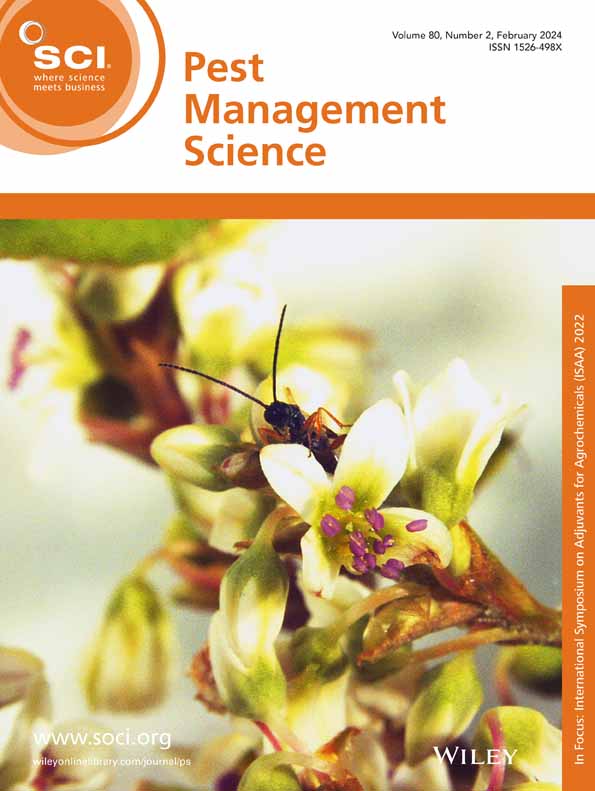Mechanisms mediating false codling moth, Thaumatotibia leucotreta (lepidoptera: Tortricidae), mating disruption using point‐source pheromone dispensers
IF 3.8
1区 农林科学
Q1 AGRONOMY
引用次数: 0
Abstract
BACKGROUNDFalse codling moth (FCM) is a polyphagous Tortricid moth that is a priority agricultural pest. Mating disruption shows potential as an environmentally friendly and sustainable control option against FCM in stone fruit, table grapes and citrus. How the technique alters the mate‐finding ability of FCM and what factors are important to ensure the control success is uncertain. Recent work indicated that Lepidoptera are disrupted either competitively or non‐competitively. No studies have yet been conducted on FCM to determine its disruptive mechanism. However, studies conducted on closely related species have proposed and critically evaluated a framework, along with a dichotomous key, for distinguishing between the two mechanisms.RESULTSA protocol for identifying the underlying disruption mechanism in other species is provided. Here the dosage‐response profile, the optimal dosage and optimal density were calculated from multiple mark‐release‐recapture (MRR) experiments, using sterile FCM. Stone fruit and table grape blocks were treated with increasing levels of pheromone dispenser densities, which allowed the level of disruption experienced (FCM caught in treated/untreated blocks) to be calculated. While mating disruption proved highly effective in stone fruit and table grapes against FCM, the FCM followed a hybrid disruption profile and were disrupted competitively at low dosages and non‐competitively at higher dosages.CONCLUSIONThe shift to non‐competitive disruption, which resulted in 99% disruption, was achieved at a dosage of 800 dispensers/ha uniformly distributed and remained effective with as few as 36 pheromone release sites per ha. Mating disruption is, therefore, highly recommended to form part of the current integrated pest management program for FCM. © 2025 The Author(s).

利用点源信息素分配器介导假冷蛾,白斑蛾(鳞翅目:蛾科)交配中断的机制
背景假冷蛾(FCM)是一种多食性的圆蛾,是农业害虫。在核果、鲜食葡萄和柑橘中,交配中断作为一种环保和可持续的控制FCM的选择具有潜力。该技术如何改变FCM的择偶能力以及哪些因素对确保控制成功是重要的尚不确定。近年来的研究表明鳞翅目具有竞争性和非竞争性。目前还没有关于FCM的研究来确定其破坏机制。然而,对密切相关物种进行的研究已经提出并批判性地评估了一个框架,以及区分这两种机制的二分法。结果提供了在其他物种中鉴定潜在破坏机制的sa方案。在这里,使用无菌流式细胞仪通过多次标记释放-再捕获(MRR)实验计算剂量-反应曲线、最佳剂量和最佳密度。在核果和鲜食葡萄块上增加信息素分配器密度,从而可以计算所经历的破坏水平(处理/未处理块中捕获的FCM)。虽然交配破坏在核果和鲜食葡萄中对FCM非常有效,但FCM遵循杂交破坏特征,在低剂量下被竞争性破坏,在高剂量下被非竞争性破坏。结论在800支/公顷均匀分布的剂量下,可实现非竞争性干扰,干扰率达99%,且每公顷仅释放36个费洛蒙位点。因此,强烈建议将交配中断作为目前FCM综合虫害管理计划的一部分。©2025作者。《病虫害管理科学》由John Wiley &出版;我代表化学工业协会的儿子有限公司。
本文章由计算机程序翻译,如有差异,请以英文原文为准。
求助全文
约1分钟内获得全文
求助全文
来源期刊

Pest Management Science
农林科学-昆虫学
CiteScore
7.90
自引率
9.80%
发文量
553
审稿时长
4.8 months
期刊介绍:
Pest Management Science is the international journal of research and development in crop protection and pest control. Since its launch in 1970, the journal has become the premier forum for papers on the discovery, application, and impact on the environment of products and strategies designed for pest management.
Published for SCI by John Wiley & Sons Ltd.
 求助内容:
求助内容: 应助结果提醒方式:
应助结果提醒方式:


